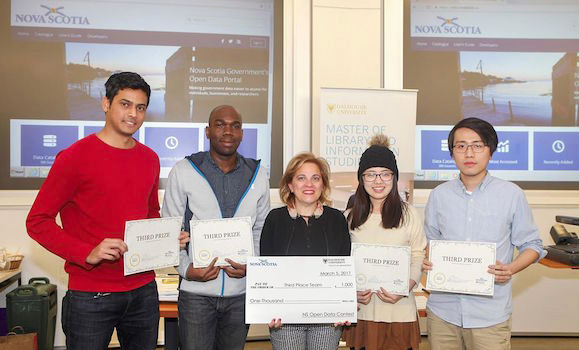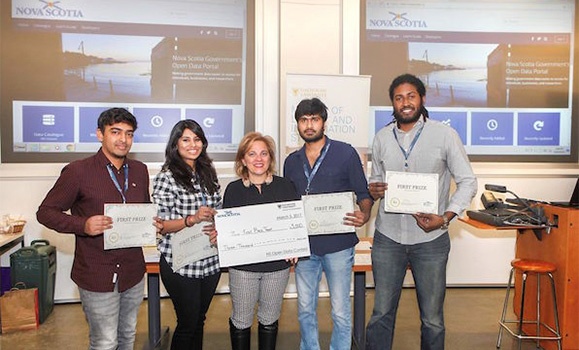In late January, Sandra Toze, director of the School of Information Management (SIM), spoke with Connie Michaelis, director of the corporate information management program in Nova Scotia’s Department of Internal Service.
The one-year anniversary of Nova Scotia’s open data portal was coming up, and Michaelis was looking for a quote from Dr. Toze about the importance of data. Michaelis also expressed the province’s desire to host an open data competition. By the end of the conversation, a date was set for early March. SIM and the Rowe School of Business (RSB) would host.
“One reason we said yes is because we have the skills and resources and we’re interested in building data capacity in the province,” says Dr. Toze. “It really ties into SIM’s core mission of ensuring that we are training people for the digital future.”
Michael Bliemel, who teaches business analytics in the RSB, adds that both schools use the portal: “We have a lot of faculty who teach courses with open data who mentored the competitors, and that made this event a success.”
The competition took place on International Open Data Day (March 4), which highlights growing recognition of the importance of open data.
Making use of open data
Open data is information collected by the government and made available to the public.
“The whole idea is that releasing the data allows people to link it to other types of data and create helpful new apps,” explains Dr. Toze. “It helps the community and has an economic spinoff as well.”
Dr. Bliemel points out that since data collection is made possible by taxpayers, it makes sense for it to be available to them. The province’s portal has approximately 400 data sets, he explains, “and they keep adding more.”
Nova Scotia was inspired to run the competition in partnership with the RSB and SIM not only to promote the portal but also to engage youth.
“These types of contests are so important, not just for highlighting how open data can be used, but also for collaboration and engagement opportunities,” says Michaelis. “Seeing these diverse groups of young people come together and create something innovative with our data was exciting and inspiring.”
This is the first such competition that Nova Scotia has engaged in, and while Halifax has run similar contests, says Dr. Bliemel, “it’s the first one that was open to a broad group with predictive models and visualizations, not just apps.”
An open competition for all
Indeed, the competition, which took place March 4-5, was open to anyone, and although the entrants were mostly students from institutions around HRM, says Dr. Toze, “We had a couple people who came in with very little experience just to see what they were able to learn and produce.” She notes that many competitors were fairly new to Nova Scotia, and in some cases to Canada.
The object of the competition was to use data from the province’s portal to produce an app, a visualization or a predictive model in one of three areas: immigration, environmental protection and natural resource management, and tourism. Fifty-four entrants in 16 teams worked over the weekend and then presented their projects to a panel of judges.
“What it comes down to is that they have two minutes to sell us on their idea,” says Dr. Toze. “There was a lot of energy in the room,” notes Dr. Bliemel. “It was very exciting.”
Teams were judged on their innovative use of technology; how beneficial their product was to its intended audience; the product‚Äôs aesthetics; and the quality of the team‚Äôs presentation. The winners, three students from Saint Mary‚Äôs University and one from AVæ„¿÷≤ø, chose the environmental management theme, using data on Crown land, wind speeds and power consumption to visualize a predictive model of the best places in Nova Scotia for wind farms.
“That was creating something new, and allowed for business decisions based on the data,” notes Dr. Toze.
The second-place winners took tourism as their theme and created an app to help find and book campsites. Tied for third place was a team that predicted the chemical composition of lake water, and a AVæ„¿÷≤ø team (pictured below) that delved into the immigration theme with an app to help newcomers to the HRM choose the best place to live.
 Third-place team (L to R): Jabez Harris, Alif Momin, Zehao Ba and Zhishen Yang with Minister Lena Metlege Diab (centre). Photo: Communications Nova Scotia
Third-place team (L to R): Jabez Harris, Alif Momin, Zehao Ba and Zhishen Yang with Minister Lena Metlege Diab (centre). Photo: Communications Nova Scotia
A real-world environment
Connie Zheng, a business analytics and finance student in the RSB's Corporate Residency MBA program, collaborated with a classmate to produce an app that visualizes information about Nova Scotia’s Provincial Nominee Program for immigrants.
“The open data contest provided me with chances to make meaningful analysis in a real-world environment,” explains Zheng, who believes that data analytics is vital to business: “If more business people, including students, learn about data analytics, it will drive a culture shift towards business intelligence.” Zheng says she’d happily participate in the competition again.
“I got exposed to a bunch of inspiring new ideas, which really opened my eyes,” she says.
Chevonne Lyons, manager of information management in the Department of Internal Services, was one of the provincial officials at the contest.
“The level of work, the presentations, and the solutions the teams created were impressive — especially considering they only had two days to complete their submissions,” she says. “It was a wonderful weekend and meeting and engaging with the competitors was a high point.”
Both Dr. Bliemel and Dr. Toze are keen to host the competition again next year, with a few changes. “We want to start earlier and ensure that there are opportunities beyond the day for students,” says Dr. Toze.
That last goal is important to both the schools and the province. “The idea that Connie had was to involve the students and different departments,” says Dr. Toze. “If they saw any ideas that they liked, it could lead to offering the students internships and potentially jobs.” A criticism that is sometimes levelled at similar events, says Dr. Toze, is that they build up creativity and energy but are one-off events.
“So we want to work with the province,” she says, “to make sure that all of these ideas actually make it into the government and become reality.”

